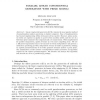247 search results - page 26 / 50 » On Pseudorandom Generators in NC |
STACS
2012
Springer
12 years 3 months ago
2012
Springer
We consider the classical rumor spreading problem, where a piece of information must be disseminated from a single node to all n nodes of a given network. We devise two simple pus...
VLSID
2002
IEEE
14 years 8 months ago
2002
IEEE
| This paper reports the design of a Test Pattern Generator (TPG) for VLSI circuits. The onchip TPG is so designed that it generates test patterns while avoiding generation of a gi...
FCCM
2003
IEEE
14 years 25 days ago
2003
IEEE
Two FPGA based implementations of random number generators intended for embedded cryptographic applications are presented. The first is a true random number generator (TRNG) whic...
PC
1998
13 years 7 months ago
1998
Linear congruential generators (LCGs) remain the most popular method of pseudorandom number generation on digital computers. Ease of implementation has favored implementing LCGs wi...
DATE
1997
IEEE
13 years 11 months ago
1997
IEEE
Many Built-In Self Test pattern generators use Linear Feedback Shift Registers (LFSR) to generate test sequences. In this paper, we address the generation of deterministic pairs o...

